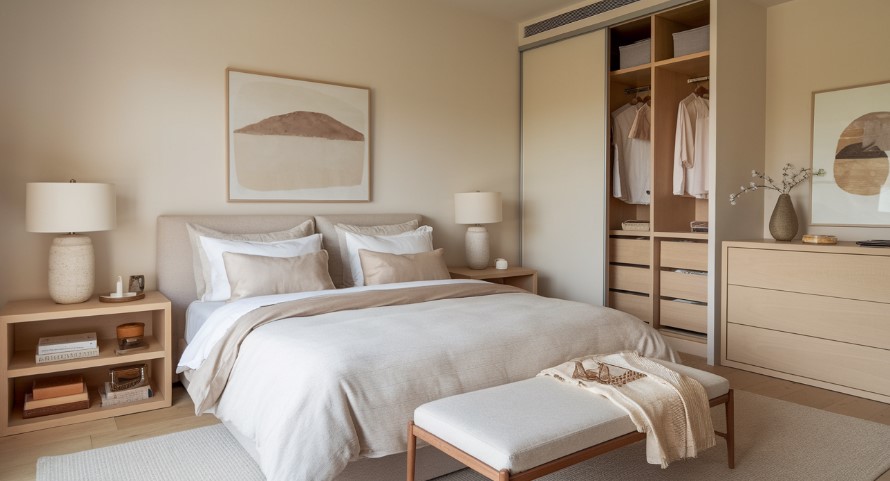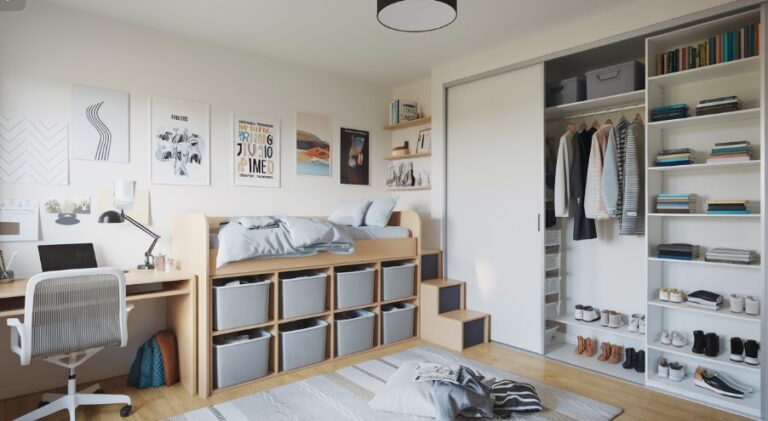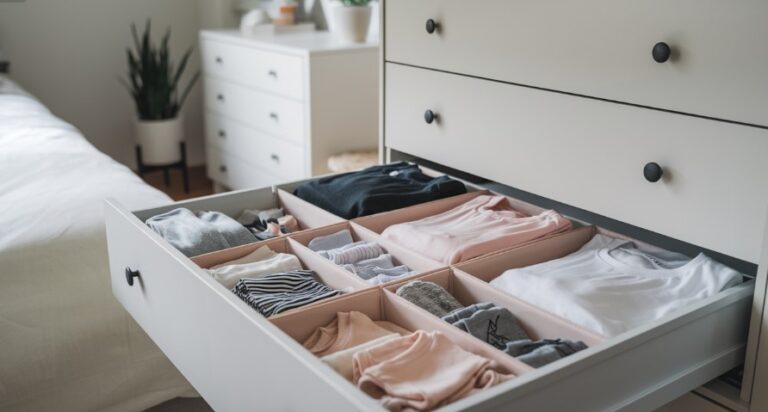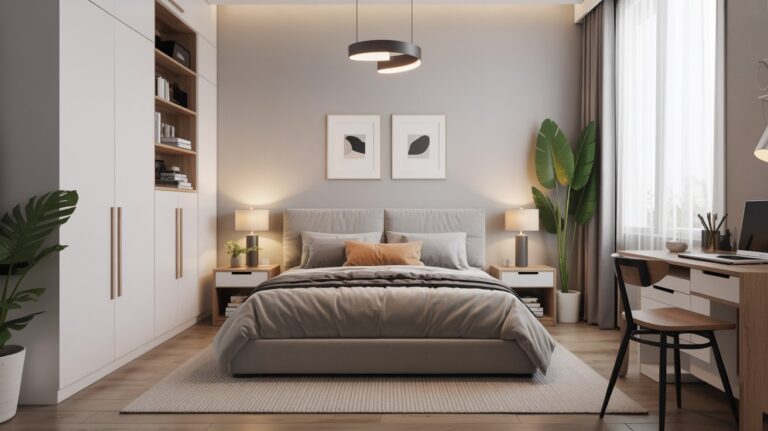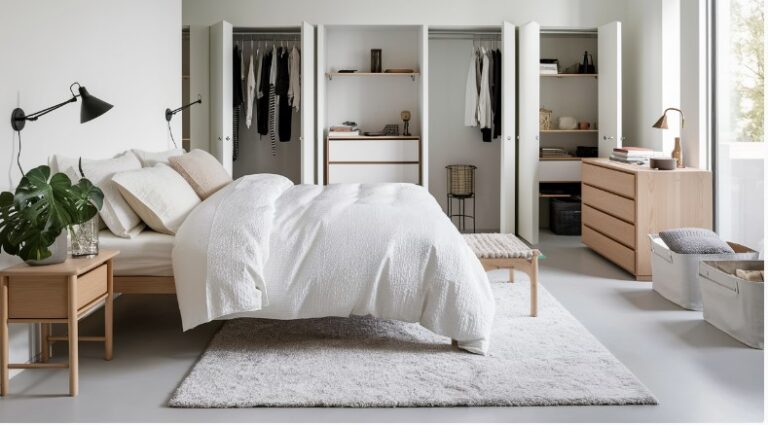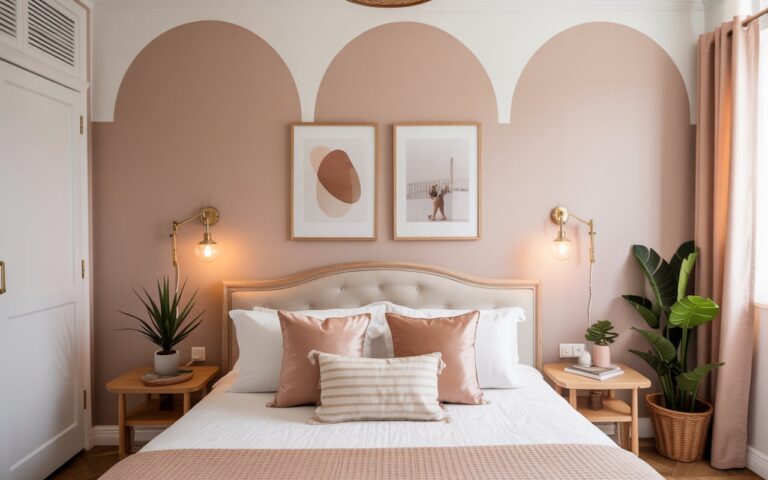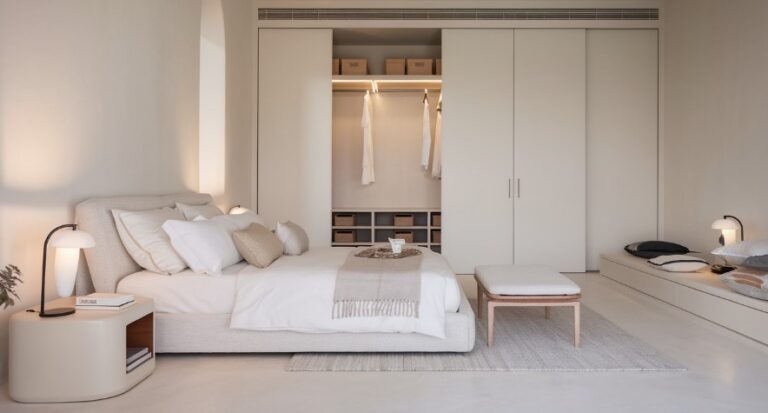5 Must Bedroom decluttering for couples
Decluttering a bedroom goes beyond tidying. It’s about making a calm space for couples.
Busy lives need bedrooms to be peaceful. They should be free of clutter, allowing for reconnection and rest.
This guide offers tips for couples to declutter their shared space.
Steps include organizing the wardrobe and finding spots for personal items. The goal is to foster peace and intimacy.
Join us to discover tips for couples on bedroom decluttering. See how a simpler space can enhance your relationship and life.
1. Communicate and Set Expectations
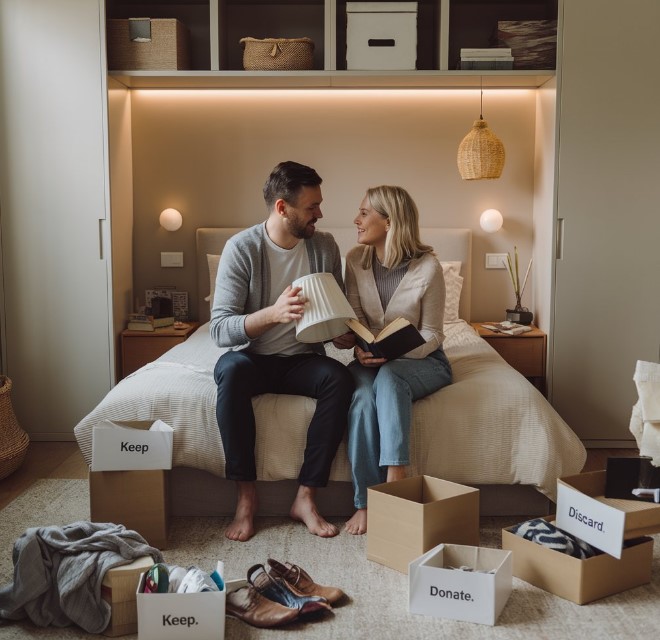
Clear communication is vital for couples to declutter their bedrooms. Discuss your goals and expectations with transparency.
This ensures both partners are on the same page. Deciding together on items to keep, donate, or throw away fosters teamwork. It makes everyone feel valued.
Compromise is key for shared spaces and belongings. Both partners may have attachments or preferences. Rank what matters most to each of you.
Consider rotating items, creating storage solutions, or being creative to meet both needs.
Couples can enhance relaxation, intimacy, and respect by; Communicating, Setting expectations, Compromising.
2. Tackle the Closet First
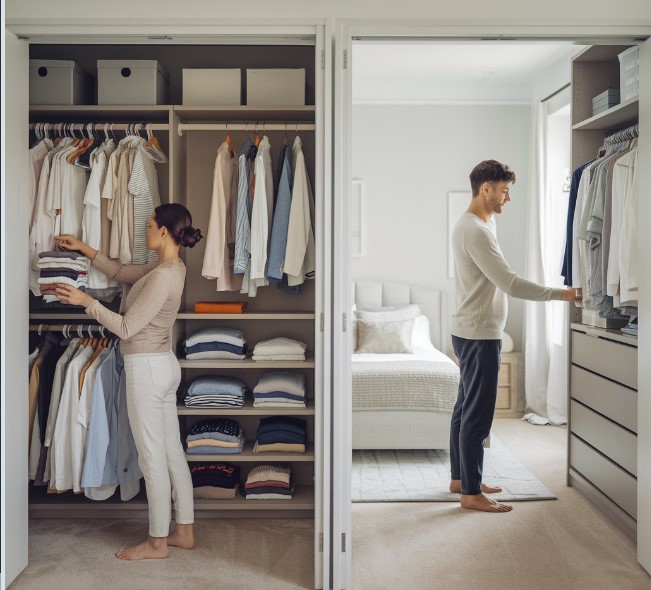
For a couple’s shared bedroom, start decluttering with the closet. It will create an organized and functional space. Start by focusing on your side of the closet. Then, tackle your partner’s things.
This approach allows for more efficient decluttering. Each person can decide about their items without distraction.
Consider creating a capsule wardrobe for each of you to cut excess clothing. Choose versatile pieces that combine seamlessly. This keeps your wardrobe practical and clutter-free.
Further sort clothes by type (e.g., shirts, pants), use (daily vs. occasional), and season (summer, winter). This will streamline your dressing routine all year.
By prioritizing these steps, you will maximize closet space. You will also promote harmony and order in your shared bedroom.
Decluttering together can boost your bond. It will create a calm space to relax and rejuvenate.
3. Designate Spaces for Shared Items
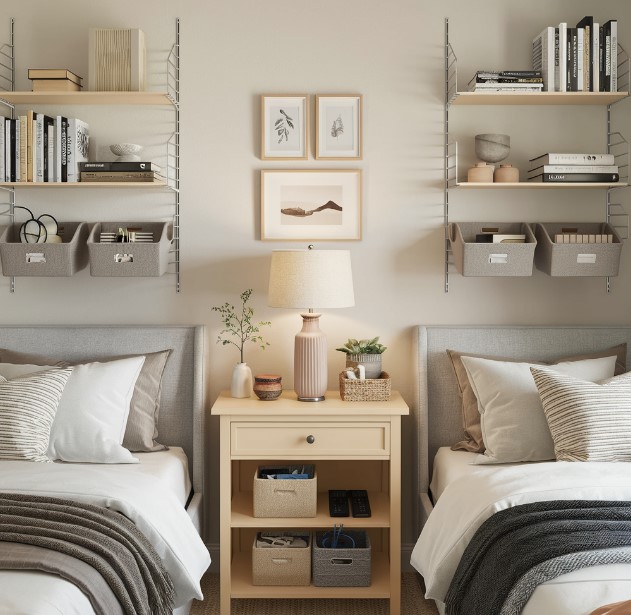
When decluttering a couple’s bedroom, create specific spots for shared items. This boosts organization and harmony.
Designate areas for electronics, books, and decor. This way, each partner knows where to find and return things. It reduces clutter and promotes order.
Use shelves, baskets, or organizers for shared items. This keeps everything tidy and easy to reach.
Shelves can hold books and decor. Baskets are ideal for small items like remotes and chargers, preventing surface clutter.
Set clear rules for shared spaces. Agreements to clean up, declutter, and respect storage preferences are useful.
These guidelines help couples keep their bedroom clean and organized. This fosters relaxation and intimacy.
4. Regularly Rotate Seasonal Items
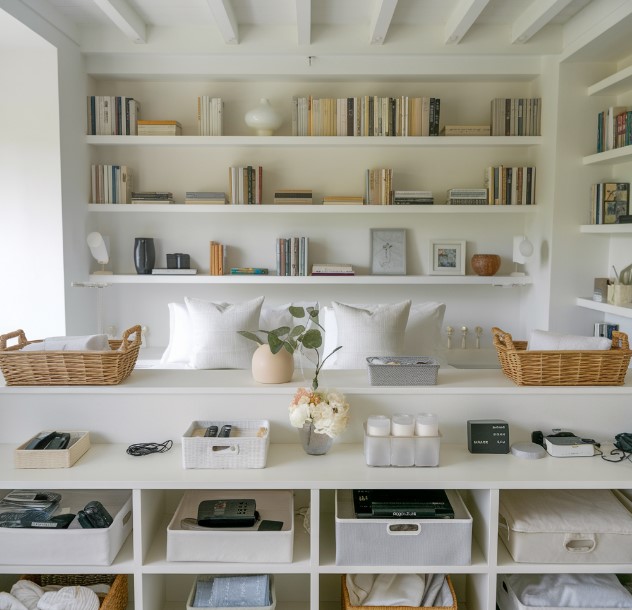
When decluttering a couple’s bedroom, consider both partners. Create personal spaces and a shared area. Assign spots for shared items like electronics, books, and décor. This cuts down on clutter.
Use shelves, baskets, or organizers for easy access. Choose furniture that serves multiple purposes. For example, use bedside tables with drawers or storage ottomans.
Set rules for shared spaces. Agree on habits like returning items or regular cleaning. This teamwork fosters order and respect.
These strategies help couples create a calm, organized bedroom. It should reflect their tastes and promote relaxation.
5. Maintain a Clutter-Free Bedroom
A clutter-free bedroom is vital for couples. It helps create a calm, harmonious space.
Start by returning items to their designated spots after use. This simple practice prevents accumulation and preserves the bedroom’s peaceful atmosphere.
Regular assessments of belongings hold the same level of importance. Test items together on a regular basis. Remove those with no purpose or value.
This approach clears clutter and promotes intentional living.
Communication is key in maintaining a clutter-free environment. Couples should support each other in this. They should give gentle reminders and motivation when needed.
Mutual encouragement creates a shared duty to keep your bedroom tidy and inviting.
Consistent use of these practices can transform your bedroom. It can be a calming retreat. Both partners can relax, unwind, and reconnect in a clutter-free space.
Conclusion
Decluttering your bedroom as a couple isn’t just about organizing. It’s about creating a space where both can find solace and connection.
Daily habits and regular checks will keep a clutter-free space. This fosters calm and harmony.
Encouraging each other strengthens your bond and shared goals. It promotes a peaceful living space.
It’s a journey to create a sanctuary that reflects your values and promotes well-being.
As you start this journey together, celebrate your progress. Enjoy a clutter-free bedroom. It will be a relaxing, intimate space. It will nurture your relationship and improve your life.
1. How can we start the process of decluttering our bedroom as a couple?
Decluttering your bedroom together can strengthen your bond. First, set a common goal.
Decide why. Is it for relaxation, more space, or less stress? Then, pick a time when both are free.
Sort items into keep, donate, sell, or toss. Focus on one area at a time: closets, dressers, or under the bed.
Respect each other’s things and memories. Discuss disagreements. Try to find a middle ground.
Use bins, shelves, and organizers to stay tidy. Set rules for what remains in the bedroom.
Regularly check and update your space. With teamwork and communication, you can achieve an organized, peaceful bedroom.
2.What are some common challenges couples face when decluttering their bedroom?
Couples face common challenges when decluttering their bedroom. The main issue is different attachments to items.
One partner might cherish something, while the other sees it as trash. This can lead to fights and slow progress.
Another problem is differing organizing styles. One might want a minimalist look, while the other prefers a cozy, lived-in feel. This makes finding a middle ground tough.
Time is also a challenge. Busy schedules make it hard to find time to declutter together.
Letting go of sentimental items can be stressful, causing delays or avoidance.
It’s tough to decide what to keep, donate, or toss, with strong opinions involved.
Communication and compromise are key. They help overcome these challenges and create a tidy, harmonious space.
3. How can we decide which items to keep and which to discard when we have different preferences?
People have different opinions on what to keep or toss. A careful, inclusive method is vital.
First, set clear rules that focus on usefulness, sentimental value, and practicality. Then, discuss. We should hear everyone’s views and compare them to these rules.
This method builds understanding. It ensures choices consider more than personal feelings or practicality.
Using compromise and negotiation helps resolve conflicting views. This could mean sharing items, finding new uses, or donating them.
Recognizing emotional ties and the stress of letting go is important too.
Encouraging open talk and understanding leads to better decisions.
The goal is a decision that respects all views. It must meet both practical and emotional needs.
By blending logic with compassion, we can handle differing views and please everyone.
4. What strategies can we use to maintain a clutter-free bedroom in the long term?
Keeping your bedroom clutter-free needs regular effort and smart organization.
First, designate storage for each item using shelves, baskets, or drawers. This makes it easy to find things.
Next, declutter regularly—monthly or seasonally—to avoid accumulating unnecessary items.
Choose furniture with built-in storage. For example, beds with drawers and nightstands with compartments.
Always put things away after use. This prevents clutter on surfaces.
Choose organizers or bins that match your bedroom’s style. This not only improves the look but also encourages maintenance.
Finally, keep only what’s essential. Only keep items that are sentimental, joyful, or useful.
It will be a peaceful space for sleep. By following these strategies, you can create a calm, clutter-free bedroom.
5. How can we effectively organize our closet space to accommodate both partners’ belongings?
Organizing a closet for both partners’ belongings takes careful planning. It must consider each person’s needs and preferences.
First, declutter. Assess what items are essential. Store or donate the rest.
Use storage solutions like bins, shelves, and hanging organizers. They will maximize vertical space and create separate sections for each partner’s items.
Consider using a color-coded system or labels to tell clothing apart from accessories.
Another strategy is to rotate seasonal items. Store off-season clothes in bins or vacuum-sealed bags to free up space.
Agree on organizing rules that work for both partners. For example, arrange clothes by type or color. Ensure they are accessible and functional.
Also, space-saving hangers or cascading hooks can save space for long and short items.
Lastly, regular maintenance is crucial to sustaining an organized closet. Schedule regular reviews to remove unused, outdated items. This will maintain the organization system.
Use these strategies and discuss storage needs. You can then create a closet that fits both partners’ things.
6. Are there any specific decluttering methods or philosophies that work well for couples?
Decluttering as a couple can be tough but rewarding. It requires good communication and shared goals.
A good method is the “one in, one out” rule. It says to remove an item for each new one brought into the home.
This promotes mindfulness about acquiring new possessions and keeps clutter from accumulating.
Another approach is the KonMari method. It asks if items “spark joy” for each partner.
It encourages respect for sentimental attachments while reducing excess belongings.
Designating spaces for personal versus shared items can reduce clutter and disputes.
Scheduled, joint decluttering sessions can boost teamwork. They will keep our home tidy.
The key is open communication, compromise, and a shared commitment. Both partners must create a space that reflects their values and lifestyles.
